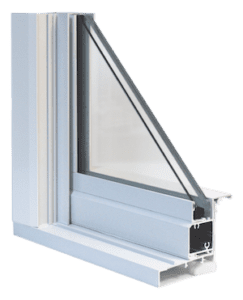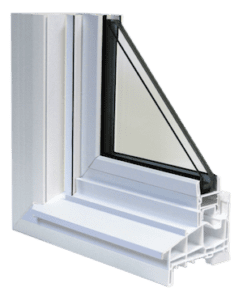Choosing the Right Windows
1. Start with the basics
1.1 – Frames

Aluminum Frames
Although very strong, light, and almost maintenance-free, metal or aluminum window frames conduct heat rapidly, making metal an inferior insulating material.
To reduce heat flow, metal frames should have a thermal break – an insulating plastic strip placed between the inside and outside of the structure and sash.

Vinyl Frames
Vinyl window frames are made of polyvinyl chloride (PVC) with ultraviolet light (UV) stabilizers to keep sunlight from breaking down the material. Vinyl window frames do not require painting and have good moisture resistance. The hollow cavities of vinyl frames can be filled with insulation, which makes them thermally superior to standard vinyl and wood frames.
1.2 Glass
Laminated Glass
Laminated hurricane impact-resistant glass, “the sandwich,” comprises two glass panes bonded with a protective interlayer to form a powerful glass unit that functions as a single pane. “The sandwich” is the primary barrier used in impact-resistant windows and doors during extreme weather events or to deter potential intruders.
Laminated Insulating glass adds an extra single pane to the laminated glass unit with a sealed air or argon-filled space in between to help reflect outside heat so indoor temperatures fluctuate less. This offers greatly enhanced energy performance.
PGT’s laminated insulating glass has ZERO reported seal failures for over five years, compared to an industry average of 2% yearly failure rate.
Low-E
Deflects the sun’s heat to boost energy savings while keeping your indoor climate comfortable.
Glass
Available in shades to reduce heat transmitted through windows and doors, even in the sunniest regions.
Gray and bronze tints reduce light and heat penetration into your home.
Blue and green tints provide greater visible light penetration, slightly reducing heat transfer compared to other tint shades.
Gray and bronze tints reduce light and heat penetration into your home.
Blue and green tints provide greater visible light penetration, slightly reducing heat transfer compared to other tint shades.
Argon
It helps reflect outside heat, so indoor temperatures fluctuate less.
2. Check the ratings
U-FACTOR: This mandatory rating measures the heat inside your home that can escape through a window and is the top-left number on all NFRC labels.
- Rating range: 0.10 – 2.00 (this may vary, but is a typical range)
- A lower number means less heat loss
- BUYERS TIP: In cold climates, windows with low U-factors help reduce heating costs
SOLAR HEAT GAIN COEFFICIENT: This mandatory rating measures the amount of solar heat sun that can enter a home through a window and is the top-right number on all NFRC labels.
- Rating range: 0.00 – 1.00
- A lower number means less heat gain.
- BUYERS TIP: In hot climates, windows with a low rating can reduce cooling costs
VISIBLE TRANSMITTANCE: This mandatory rating measures the amount of solar light that can enter a home through a window. The rating can be found on the middle or bottom row of an NFRC label on the left side.
- Rating range: 0.00 – 1.00
- A higher number means more natural light.
- BUYERS TIP: Windows with a high rating may reduce your dependence on artificial lighting and lower monthly utility bills
AIR LEAKAGE: This optional rating measures the volume of air that can infiltrate a home through a window. This rating can be found on the middle or bottom row of an NFRC label on the right side.
- Rating range: less than or greater than 0.3
- A lower number means less air leakage
- BUYERS TIP: windows rated higher than 0.3 in this specific category disqualify a building from ENERGY STAR certification
3. Find rebates and incentives
4. Focus on proper installation
Without proper installation, even the best windows may not perform as expected. At VAV Home Solutions, we ensure every project is completed per the strictest quality standards by having factory-trained experts handle the installation.
